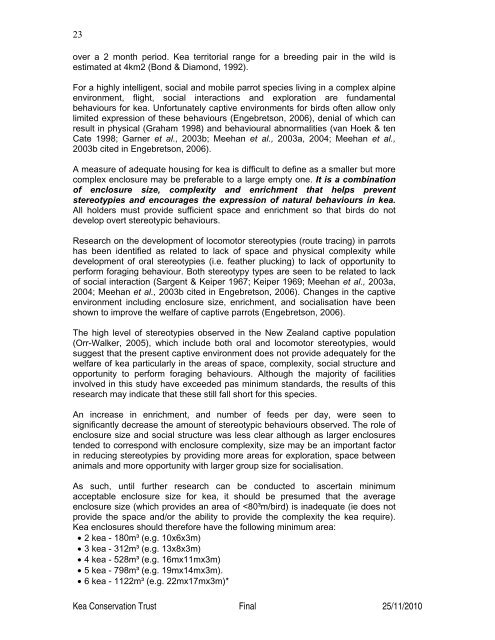(Nestor notabilis) Husbandry Manual - Kea Conservation Trust
(Nestor notabilis) Husbandry Manual - Kea Conservation Trust
(Nestor notabilis) Husbandry Manual - Kea Conservation Trust
Create successful ePaper yourself
Turn your PDF publications into a flip-book with our unique Google optimized e-Paper software.
23<br />
over a 2 month period. <strong>Kea</strong> territorial range for a breeding pair in the wild is<br />
estimated at 4km2 (Bond & Diamond, 1992).<br />
For a highly intelligent, social and mobile parrot species living in a complex alpine<br />
environment, flight, social interactions and exploration are fundamental<br />
behaviours for kea. Unfortunately captive environments for birds often allow only<br />
limited expression of these behaviours (Engebretson, 2006), denial of which can<br />
result in physical (Graham 1998) and behavioural abnormalities (van Hoek & ten<br />
Cate 1998; Garner et al., 2003b; Meehan et al., 2003a, 2004; Meehan et al.,<br />
2003b cited in Engebretson, 2006).<br />
A measure of adequate housing for kea is difficult to define as a smaller but more<br />
complex enclosure may be preferable to a large empty one. It is a combination<br />
of enclosure size, complexity and enrichment that helps prevent<br />
stereotypies and encourages the expression of natural behaviours in kea.<br />
All holders must provide sufficient space and enrichment so that birds do not<br />
develop overt stereotypic behaviours.<br />
Research on the development of locomotor stereotypies (route tracing) in parrots<br />
has been identified as related to lack of space and physical complexity while<br />
development of oral stereotypies (i.e. feather plucking) to lack of opportunity to<br />
perform foraging behaviour. Both stereotypy types are seen to be related to lack<br />
of social interaction (Sargent & Keiper 1967; Keiper 1969; Meehan et al., 2003a,<br />
2004; Meehan et al., 2003b cited in Engebretson, 2006). Changes in the captive<br />
environment including enclosure size, enrichment, and socialisation have been<br />
shown to improve the welfare of captive parrots (Engebretson, 2006).<br />
The high level of stereotypies observed in the New Zealand captive population<br />
(Orr-Walker, 2005), which include both oral and locomotor stereotypies, would<br />
suggest that the present captive environment does not provide adequately for the<br />
welfare of kea particularly in the areas of space, complexity, social structure and<br />
opportunity to perform foraging behaviours. Although the majority of facilities<br />
involved in this study have exceeded pas minimum standards, the results of this<br />
research may indicate that these still fall short for this species.<br />
An increase in enrichment, and number of feeds per day, were seen to<br />
significantly decrease the amount of stereotypic behaviours observed. The role of<br />
enclosure size and social structure was less clear although as larger enclosures<br />
tended to correspond with enclosure complexity, size may be an important factor<br />
in reducing stereotypies by providing more areas for exploration, space between<br />
animals and more opportunity with larger group size for socialisation.<br />
As such, until further research can be conducted to ascertain minimum<br />
acceptable enclosure size for kea, it should be presumed that the average<br />
enclosure size (which provides an area of












